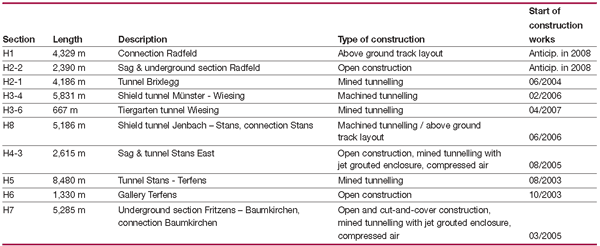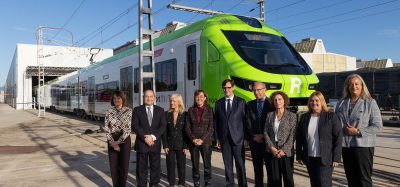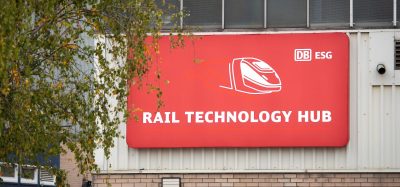Construction of the new Lower Inn Valley Railway
Posted: 26 November 2007 | | No comments yet
The construction of the new Lower Inn Valley Railway is one of Austria’s largest infrastructure projects. By 2012, the first section of the Northern feeder line to the Brenner base tunnel will be constructed on a length of ca. 40 kilometres.
The construction of the new Lower Inn Valley Railway is one of Austria’s largest infrastructure projects. By 2012, the first section of the Northern feeder line to the Brenner base tunnel will be constructed on a length of ca. 40 kilometres.
The construction of the new Lower Inn Valley Railway is one of Austria’s largest infrastructure projects. By 2012, the first section of the Northern feeder line to the Brenner base tunnel will be constructed on a length of ca. 40 kilometres.
The roots of today’s rail development projects through the Brenner mountain with its Northern and Southern feeder lines can be traced back to the budding public awareness of the environment in the 70s and 80s of the last century as well as the ‘success’ of the new traffic routes at that time. A few years after its completion, the new Brenner motorway showed traffic development exceeding all prognoses of traffic planning. In transport policy terms it became quite clear that, in the long term, neither the industry nor the abutters would accept the continuously increasing road traffic, the related environmental pollution and the more and more frequent quality losses. Though the existing Lower Inn Valley Railway, which began operating in 1858, had been continuously modernised, it was evident that it would reach its capacity limit sooner or later. Even today, there is no synchronised passenger suburban rail service between Innsbruck and Kufstein.
In the late 80s, the first feasibility studies were commissioned for the Brenner base tunnel. Apart from the proof of technical and economical feasibility, it was clearly shown in the course of these works that one of the first steps for the tunnel project would have to be the development of the feeder lines on the Northern and Southern side of the Brenner. In 1993, feasibility was proven also for these sectors.
Italy, Austria and Germany finally agreed on the further procedure at the Brenner axis in the Memorandum of Montreux. It was found that the construction of the connection Kundl – Baumkirchen in the Tyrolean Lower Inn Valley should have top priority and all other sections should be realised according to the capacity reserves. The Montreux agreements were taken note of by the member of the European Commission in charge of Transport and the railway development on the Brenner axis was integrated into the project catalogue of the trans-European networks in 1995.
Project preparation Kundl – Baumkirchen
The Brenner Eisenbahn GmbH (BEG) was founded in 1995 for the implementation of all works for the railway axis Brenner on Austrian national territory. It took the small team with links to the project area just a short time to convince the communities directly at and abutting the construction site of the development project and to initiate the required approval procedures. While the competent expert committee was reviewing the environmental impact declaration, comprehensive major surveys for the tightening of the project runtime in the Lower Inn Valley were initiated: bore programmes, exploration tunnels and comprehensive measuring programmes provided important planning information for the further technical preparation of the project. In 1999, the environmental impact assessment could be completed with the railway line layout. In April 2002, the competent minister in Vienna signed the building permit. After comprehensive preliminary works such as subsurface developments, securing of banks of the river Inn and relocation of lines, the main works started in the middle of 2003.
Train path
The first construction phase of the new Lower Inn Valley Railway between Kundl and Baumkirchen consists of two tunnel chains as well as three connections with the existing line. There is one connection on the Western and one on the Eastern project border and another one in the central project area between Stans and Jenbach. They allow the traffic exchange between the existing line and the new line and they are constructed as open four-track sections. The two exterior tracks are allotted to the existing line and the two interior tracks to the new line. As soon as the traffic exchange has been made, the axis of the new line is lowered onto the valley floor until it finally leaves the existing line underground.
Seen from the East, an acceleration track out of the station Kundl in the direction of Innsbruck will be added to the two-track existing line and the three-track cross-section will be expanded in a four-track cross-section typical for the point of connection. The new line leaves the existing line as an underground train path and bypasses the central settlement area of Brixlegg in an arch curved to the South. The tunnel crosses under the Inn on the Western side of Brixlegg and is then routed in a shallow depth through the area of the municipalities of Münster and Wiesing. In the ‘Tiergarten’ area near Jenbach, the tunnel crosses a massive rock wall. During the construction phase, this solid rock section serves as a cavern, through which the two tunnel boring machines are brought in. After several underground crossings of the station Jenbach, the motorway, the existing line and the TIWAG underwater canal, the tunnel leads into the Stans connection.
To the West of the Stans connection, the new train path leaves the axis of the existing line, again in an underground section which passes over into a tunnel. After the crossings of the motorway and the existing line, the tunnel of the new line bypasses the settlement areas of Vomp and Terfens. To the West of Terfens, the tracks of the new line leads through a short open gallery, before being lowered once again onto the valley floor and crossing under the station of Fritzens. Near Baumkirchen, the new line finally joins the Western-most connection point of the project. Here, the railway traffic can either be routed on in the direction of Innsbruck or via the Southern bypass of Innsbruck in the direction of the Brenner.
Execution of construction work
The start of the 8.4km long tunnel Vomp to Terfens in the middle of 2003, has marked the successful beginning of the main works for the construction of the first 40km of the new Lower Inn Valley Railway between Kundl and Baumkirchen. Looking at the summary of the sections, it becomes clear that the expansion of the construction activities was made in a tight time frame, see Table 1 below.
Table 1 clearly shows not only the time frame in the development of the structural works, but also the multitude of different construction methods required for the realisation of the entire project with a tunnel share of ca. 80%. Particular challenges of this project are the groundwater and mountain water situation, the train path route in loose material and the cover of the tunnels, which in some places is very thin. In autumn 2007, the structural works are underway on a length of more than 33km; different sections have been prepared for the fitting works to start. In 2012, the first train will start operating on the new line.
Second construction phase
According to its legal obligation, BEG started the survey works for the determination of the train path in the project area for the second construction phase of the new Lower Inn Valley railway in 2005. Between Kundl and the state border near Kufstein, proposals for the continuation of the new line will be prepared by the end of 2007 and presented to the project participants as well as the abutters. The further development towards site preparation will be made in coordination with transport policy requirements and they meet the requirements for the maintenance of the operating quality of the railway axis Brenner between Munich and Verona.
Integration in ÖBB Infrastruktur Bau AG
With the Federal Railway Structure Act 2003, the Austrian federal government has enacted the new regulation of the Austrian railways. Not only was ÖBB reorganised in separate companies with clear responsibilities under the umbrella of a holding, but also the different special companies with special duties were allocated to the new structure. With effect from 1 January 2005, Brenner Eisenbahn Gmbh became a subsidiary of ÖBB Infrastruktur Bau AG. Now, another step will be taken on the path of integration into the ÖBB Group predetermined by law. At the beginning of 2008, the presently active BEG team will be integrated into ÖBB Infrastruktur Bau AG.


Table 1
OUT NOW: The Definitive Guide to Rail’s Digital Future
The rail industry is undergoing a digital revolution, and you need to be ready. We have released our latest market report, “Track Insight: Digitalisation.”
This is not just another report; it’s your comprehensive guide to understanding and leveraging the profound technological shifts reshaping our industry. We move beyond the buzzwords to show you the tangible realities of AI, IoT, and advanced data analytics in rail.
Discover how to:
- Optimise operations and maintenance with real-time insights.
- Enhance passenger services through seamless, high-speed connectivity.
- Leverage technologies like LEO satellites to improve safety and efficiency.
Featuring expert analysis from leaders at Nomad Digital, Lucchini RS, Bentley Systems and more, this is a must-read for any rail professional.







